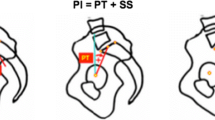Abstract
There is a high variance in sagittal morphology and complaints between different subjects suffering from spinal disorders. Sagittal spinal alignment and clinical presentation are not closely related. Different parameters have been used to describe the pelvispinal morphology based on standing lateral radiographs. We conducted a study using radiography of the lumbar spine combined with force platform data to examine the correlation between pelvispinal parameters and the gravity line position. Fifty consecutive patients with a mean age of 55 years (18–84 years) were compared to normal controls. Among patients we found a statistically significant correlation between the following spinal parameters: lumbar lordosis and sacral slope (r=0.77; P<0.001), sacral slope and pelvic incidence (r=0.72; P<0.001) and pelvic tilt and overhang (r=−0.93; P<0.001). In patients and controls, the gravity line position was found to be located at 60 and 61%, respectively, of the foot length measured from the great toe, ranging from 53 to 69%, when corrected for the individual foot length. The results indicate that subjects with and without spinal disorders have their gravity line position localised within a very small range despite the high variability for lumbar lordosis and pelvic tilt.
Résumé
L’aspect sagittal de profil de sujets présentant des problèmes rachidiens est très fréquent. Différents paramètres ont été utilisés pour décrire la morphologie du canal rachidien, avec radiographie de profil debout. Nous avons pratiqué une étude utilisant la radiographie de la colonne lombaire sur plateforme de force pour déterminer la corrélation existante entre les paramètres du canal rachidien et le centre de gravité. Cinquante patients d’âge moyen 55 ans (de 18 à 84 ans) ont été comparés à un groupe de patients contrôle. Parmi ces patients, nous avons trouvé une différence significative concernant les paramètres suivants, lordose lombaire, pente sacrée (r=0.77; P<0.001) pour la pente sacrée l’incidence pelvienne est: r=0.72; P<0.001, pour la bascule du pelvis r=0.93; P<0.001. La position du centre de gravité dans les deux groupes de patients a été localisée à 60 et 61% respectivement de la longueur du pied mesuré à partir du gros orteil et à partir de 53 à 69% lorsqu’une correction de la longueur du pied a été effectuée. Ces résultats montrent que chez les sujets avec ou sans troubles spinaux, la position du centre de gravité varie peu en dépit de grosses variations de la lordose lombaire et de la bascule pelvienne.



Similar content being viewed by others
References
Duval-Beaupere G, Robain G (1987) Visualization on full spine radiographs of the anatomical connections of the centres of the segmental body mass supported by each vertebra and measured in vivo. Int Orthop 11:261–269
Duval-Beaupere G, Schmidt C, Cosson P (1992) A Barycentremetric study of the sagittal shape of spine and pelvis: the conditions required for an economic standing position. Ann Biomed Eng 20:451–462
Gangnet N, Pomero V, Dumas R, Skalli W, Vital J-M (2003) Variability of the spine and pelvis location with respect to the gravity line: a three-dimensional stereoradiographic study using a force platform. Surg Radiol Anat 25:424–433
Graf P (1993) The EMED System of foot pressure analysis. Clin Podiatr Med Surg 10:445–454
Harms V (1992) Biomathematik, Statistik und Dokumentation. Harms Verlag, Kiel
Kitaoka HB, Alexander IJ, Adelaar RS, Nunley JA, Myerson MS, Sanders M (1994) Clinical rating system for the ankle-hindfoot, midfoot, hallux and lesser toes. Foot Ankle 15:349–353
Kluba T, Muller O, Grieb S, Zeger G, Schafer J, Niemeyer T (2004) Measurement of gravity line position 15–25 years after Harrington-spondylodesis in adolescent idiopathic scoliosis. Z Orthop 142:188–193
Lazennec J, Ramare S, Arafati N, Laudet C, Gorin M, Roger B, Hansen S, Saillant G, Maurs L, Trabelsi R (2000) Sagittal alignment in lumbosacral fusion: relations between radiological parameters and pain. Eur Spine J 9:47–55
Legaye J, Duval-Beaupere G, Hecquet J, Marty C (1998) Pelvic incidence: a fundamental pelvic parameter for three-dimensional regulation of spinal curves. Eur Spine J 7:99–103
Mac-Thiong J, Berthonnaud E, Dimar J, Betz R, Labelle H (2004) Sagittal alignment of the spine and pelvis during growth. Spine 29:1642–1647
Marty C, Boisaubert B, Descamps H, Montigny JP, Hecquet J, Legaye J, Duval-Beaupere G (2002) The sagittal anatomy of the sacrum among young adults, infants, and spondylolisthesis patients. Eur Spine J 11:119–125
Roussouly P, Gollogly S, Berthonnaud E, Dimnet J (2005) Classification of the normal variation in the sagittal alignment of the human lumbar spine and pelvis in the standing position. Spine 30:346–353
Stagnara P, De Mauroy JC, Dran G, Gonon GP, Costanzo G, Dimnet J (1982) Reciprocal angulation of vertebral bodies in a sagittal plane: approach to references for the evaluation of kyphosis and lordosis. Spine 7:335–342
Streiner DL, Norman GR (1995) From health measurements scales. A practical guide to their development and use. Oxford Medical Publications, London
Vaz G, Roussouly P, Berthonnaud E, Dimnet J (2002) Sagittal morphology and equilibrium of pelvis and spine. Eur Spine J 11:80–87
Zatsiorsky VM, King DL (1998) An algorithm for determining gravity line location from posturographic recordings. J Biom 31:161–164
Author information
Authors and Affiliations
Corresponding author
Rights and permissions
About this article
Cite this article
Geiger, E.V., Müller, O., Niemeyer, T. et al. Adjustment of pelvispinal parameters preserves the constant gravity line position. International Orthopaedics (SICOT) 31, 253–258 (2007). https://doi.org/10.1007/s00264-006-0157-0
Received:
Accepted:
Published:
Issue Date:
DOI: https://doi.org/10.1007/s00264-006-0157-0




